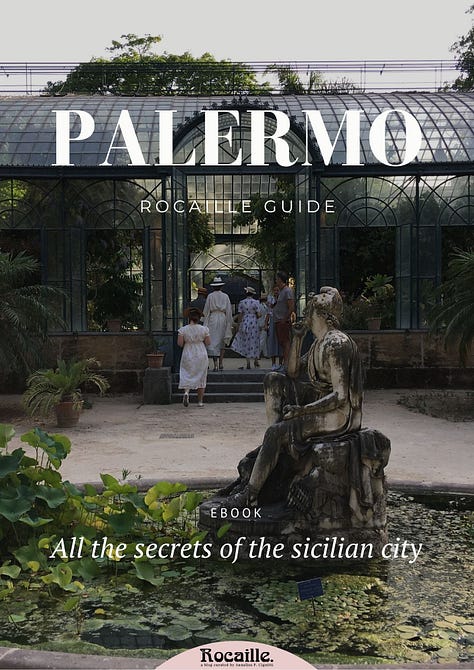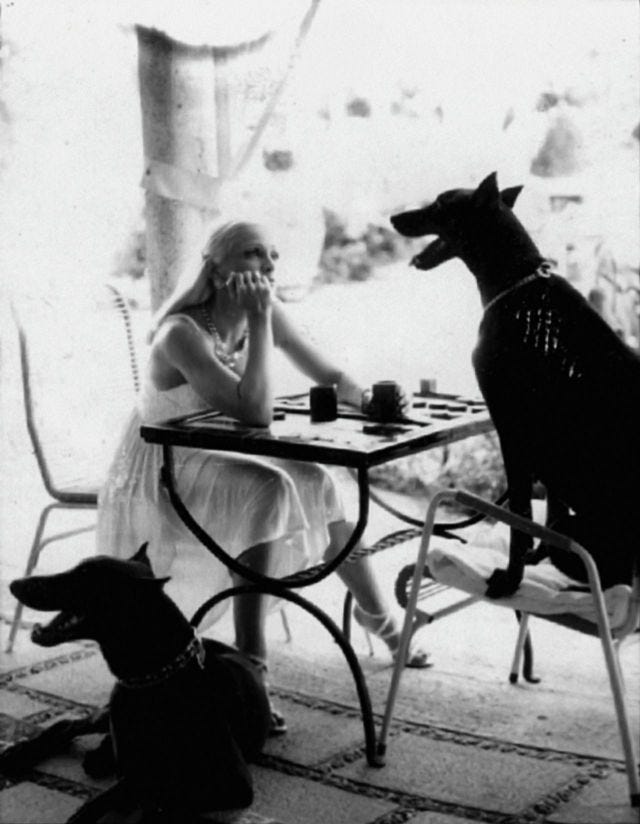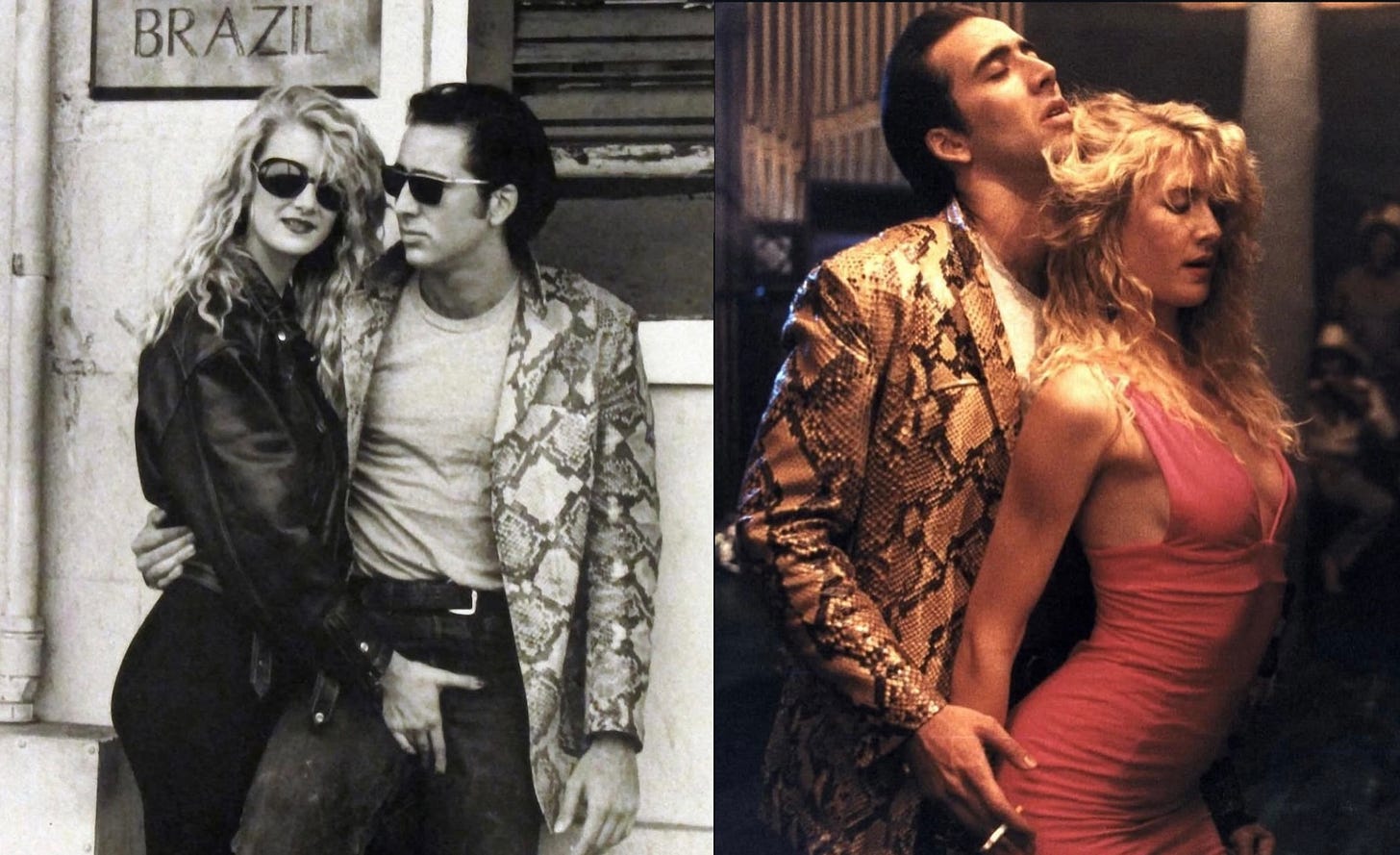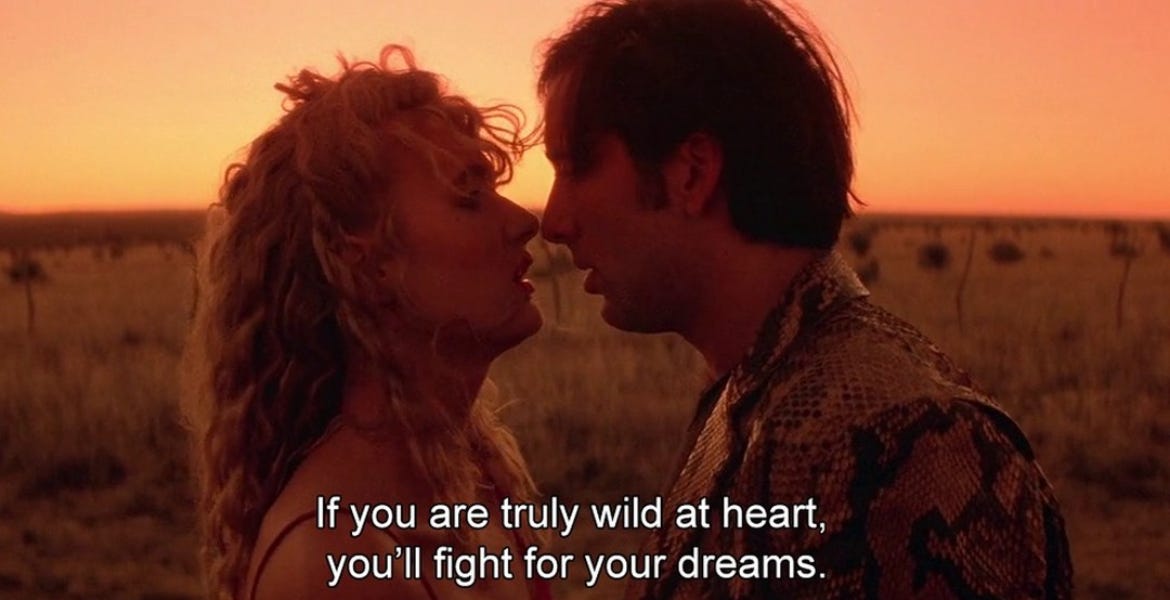#42 Rocaille Newsletter | Wild at heart
In uno mondo strano bisogna girare col coltello tra i denti: da Schopenhauer a Nicolas Cage.
Questa è la newsletter gratuita di rocaille.it. La invio ogni mese, se non volete più riceverla potete cancellarvi dal link in fondo, se invece volete passare alla versione a pagamento potete farlo cliccando qui.
This is rocaille.it's free newsletter, I send it every month, if you no longer want to receive it you can unsubscribe from the link at the bottom. If you would like to upgrade to the paid version, you can do so by clicking here.
Questo dipinto di Argio Orell (1884 – 1942), misconosciuto artista triestino, mi ha attratto per quel cane in primo piano, attento a fare da guardia alla bellezza di questa donna, che altri non è che la moglie del pittore e che porta una rosa rossa, presaga di passione.
Il tema di questa newsletter è l’essere selvaggi, la bestia indomita che vive in alcuni di noi. A seguire troverete la consueta selezione di notizie tra mostre, articoli, novità e altre cose che succedono in questo mondo. Poi ci sono i miei eventi, viaggi e ebook.
Le newsletter dei mesi precedenti potete leggerle nell’archivio.
La newsletter a pagamento del mese, che arriverà il 15 aprile, sarà una Guida insolita di Firenze, con informazioni che non ho pubblicato né sul blog né sui social, in basso potete vedere l’anteprima. Potete abbonarvi facendo una donazione minima di 30€ qui (è valida un anno).
La Rocaille Experience di quest’anno si avvicina: I segreti della Tuscia IV, dal 23 al 25 maggio. Più in basso i dettagli. Sono rimaste 5 camere!
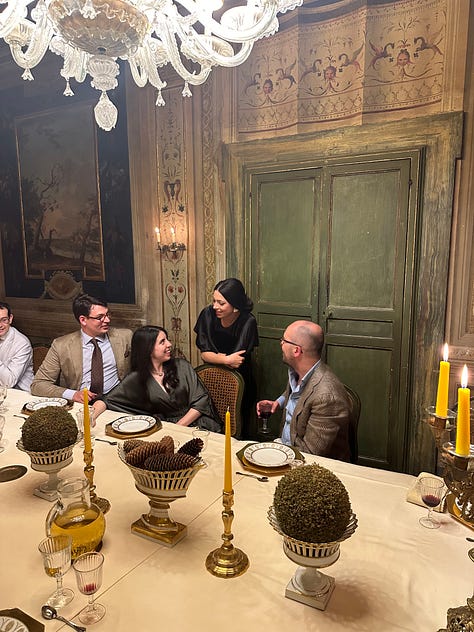
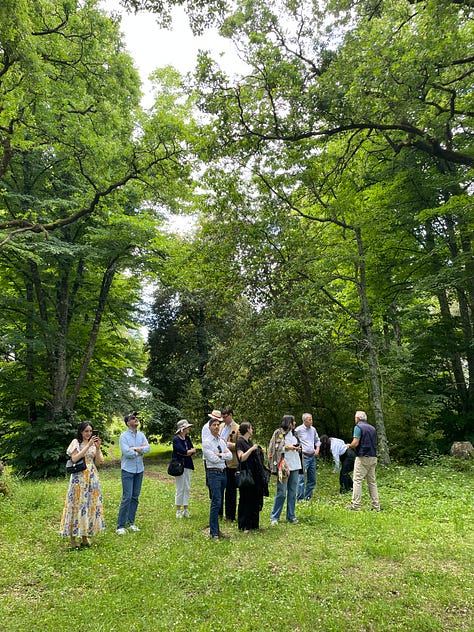
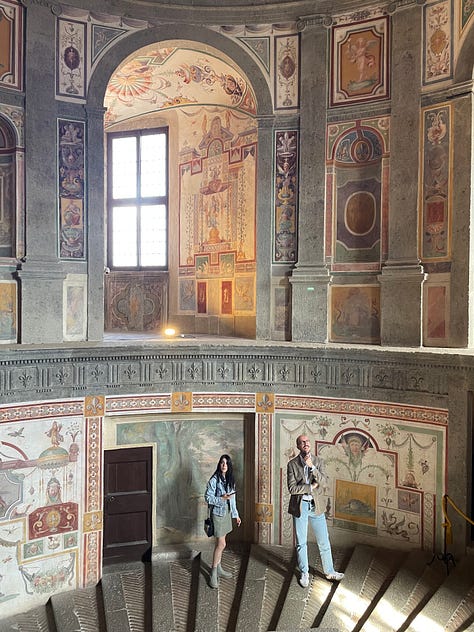
WILD AT HEART
In a weird world you have to shoot with a knife between your teeth, from Schopenhauer to Nicolas Cage.
This painting by Argio Orell, a misunderstood painter from Trieste, attracted me because of that dog in the foreground, attentive to guard the beauty of this woman, who is none other than the painter's wife, and who carries a red rose, presaging passion.
The theme of this newsletter is being wild, the untamed beast that lives in some of us. Next you will find the usual selection of news including exhibitions, articles, news and other things going on in this world. Then there are my events, travels and ebooks. Previous months' newsletters you can read in the archive.
This month's paid newsletter, coming April 15, will be an Unusual Guide to Florence, with information that I have not published either on the blog or on social, below you can see the preview. You can subscribe by making a minimum donation of 30€ here (it is valid for one year).
This year's Rocaille Experience is coming up: The secrets of Tuscia IV, May 23-25. More details below. There are 5 rooms left! BOOK HERE!
Questo mese appena concluso è stato per me particolarmente impegnativo e per questo la newsletter ha subito un leggero ritardo: a Carnevale ho fatto la mia prima gara di salto a ostacoli; poi sono stata una settimana a Maastricht per il TEFAF; per il mio compleanno, che non festeggio mai, ispirata dalla scorsa newsletter, ho fatto una piccola festa a Milano a tema trash e infine, lo scorso fine settimana, sono stata a Firenze ospite del The Hoxton Hotel, dove sono riuscita a vedere la mostra di Tracey Emin, di cui ho parlato qui. Sto scrivendo la mia guida sulla città che uscirà la prossima settimana per gli abbonati.
Questo mese sarà decisamente più calmo e intanto vi auguro Buona Pasqua!
This month that has just ended has been particularly busy for me, which is why the newsletter has been slightly delayed: at Carnival I had my first show jumping competition; then I spent a week in Maastricht for TEFAF; for my birthday, which I usually never celebrate, but inspired by the last newsletter, I had a small trash-themed party in Milan; and finally, last weekend, I was in Florence as a guest of The Hoxton Hotel, where I was able to see the Tracey Emin exhibition, which I mentioned here. I am writing my city guide which will be out next week for paying subscribers only.
This month will definitely be calmer and in the meantime I wish you a Happy Easter!
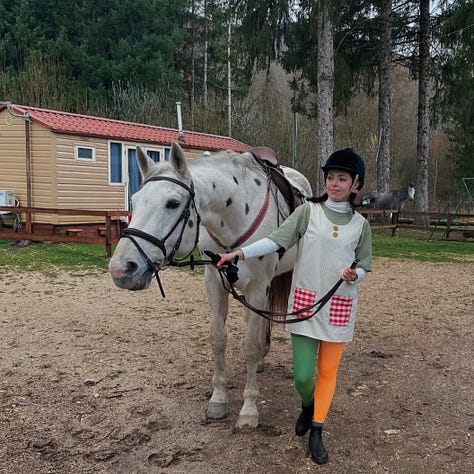


Wild at heart
Ci sono persone più vive di altre. L’ho capito mentre parlavo con una ragazza di nome Selvaggia, che ho conosciuto nel castello da fiaba in cui vive, in Toscana, circa un mese fa (ne ho parlato sul blog qui). Selvaggia, nome omen, vive per i cavalli. Nei suoi occhi c’è un lampo di vitalità indomabile, ha 27 anni e il suo sogno è quello di diventare fantina del palio di Siena. Lei, una donna. Si allena ogni giorno, si alza prestissimo la mattina e monta 4,5,6 cavalli, a pelo naturalmente. Di fronte ad una tale incrollabile volontà e una così determinata passione non si può che provare un rispetto immenso, oltre che ammirazione. A lei si addice questa frase di Virginia Woolf (1882 – 1941):
"Sia un bene o un male, non si può negare la presenza del cavallo selvaggio dentro di noi. Andare sfrenatamente al galoppo; lasciarsi cadere esausti sulla sabbia; sentire la terra girare vorticosamente; provare veramente un impeto - di amicizia per le pietre, l'erba, come se l'umanità si fosse estinta e, per quanto riguarda uomini e donne, che vadano alla malora - è un fatto ineluttabile che questo desiderio ci afferri abbastanza spesso"
Some people are more alive than others. I realized this while talking to a girl named Selvaggia, whom I met in the fairy-tale castle where she lives, in Tuscany, about a month ago (I talked about it on my blog here). Selvaggia, name omen, lives for horses. There is a flash of indomitable vitality in her eyes, she is 27 years old and her dream is to become a jockey in the Palio di Siena. She, a woman. She trains every day, gets up very early in the morning and rides 4,5,6 horses, bareback of course. In the face of such unwavering will and such determined passion, one cannot help but feel immense respect, as well as admiration. This phrase by Virginia Woolf (1882 - 1941) is fitting for her:
“Blame it or praise it, there is no denying the wild horse in us. To gallop intemperately; fall on the sand tired out; to feel the earth spin; to have - positively - a rush of friendship for stones and grasses, as if humanity were over, and as for men and women, let them go hang - there is no getting over the fact that this desire seizes up pretty often.”
Virginia Woolf, Jacob's Room
Ci sono persone che hanno un cavallo selvaggio in loro, altre no. Sono riuscite a mantenere un lato ferino e indomabile, come una bestia sempre pronta a lottare. Queste persone vivono la vita in modo pieno e se, dopo una fatica o una minima difficoltà molte si arrendono e mollano, loro invece riprendono la corsa ancora più velocemente. Vivere ardendo e non bruciarsi mai, direbbe il Vate. Ho una stima immensa per questo tipo di persone perché sono capaci di scioccare il destino, modificarlo, plasmarlo a loro piacimento. Loro vivono, gli altri sopravvivono.
E’ inutile illudersi, la vita non è che una lotta continua, c’è chi lo ha capito ed è sempre pronto a reagire e chi trascorre l’esistenza immobile, a lamentarsi che la vita fa schifo. Io la penso come Arthur Schopenhauer (1788 – 1860):
“L’uomo è in fondo un animale selvaggio e feroce. Noi lo conosciamo solo in quello stato di ammansamento e di domesticità che è detto civiltà: perciò ci spaventano le rare esplosioni della sua vera natura. Ma fate che vengano tolte le catene dell’ordine legale, e nell'anarchia l’uomo si mostrerà quale esso è.”
Arthur Schopenhauer, Scritti postumi, 1804/60 (postumo 1966/75)
Some people have a wild horse in them, others do not. They have managed to maintain a feral and untamable side, like a beast always ready to fight. These people live life to the fullest, and if, after a struggle or the slightest difficulty many give up and quit, they, on the other hand, pick up the race even faster. Live by burning and never burn out, the Vate would say. I have immense esteem for these kinds of people because they are capable of shocking fate, changing it, shaping it to their liking. They live, others survive.
It is useless to delude oneself, life is but a constant struggle, there are those who have understood this and are always ready to react and those who spend their existence motionless, complaining that life sucks. I think like Arthur Schopenhauer (1788 - 1860):
“Man is at bottom a wild and ferocious animal. We know him only in that state of taming and domesticity which is called civilization: hence we are frightened by the rare outbursts of his true nature. But let the chains of legal order be removed, and in anarchy man will show himself what he is.”
Arthur Schopenhauer, Posthumous Writings, 1804/60 (posthumously 1966/75)

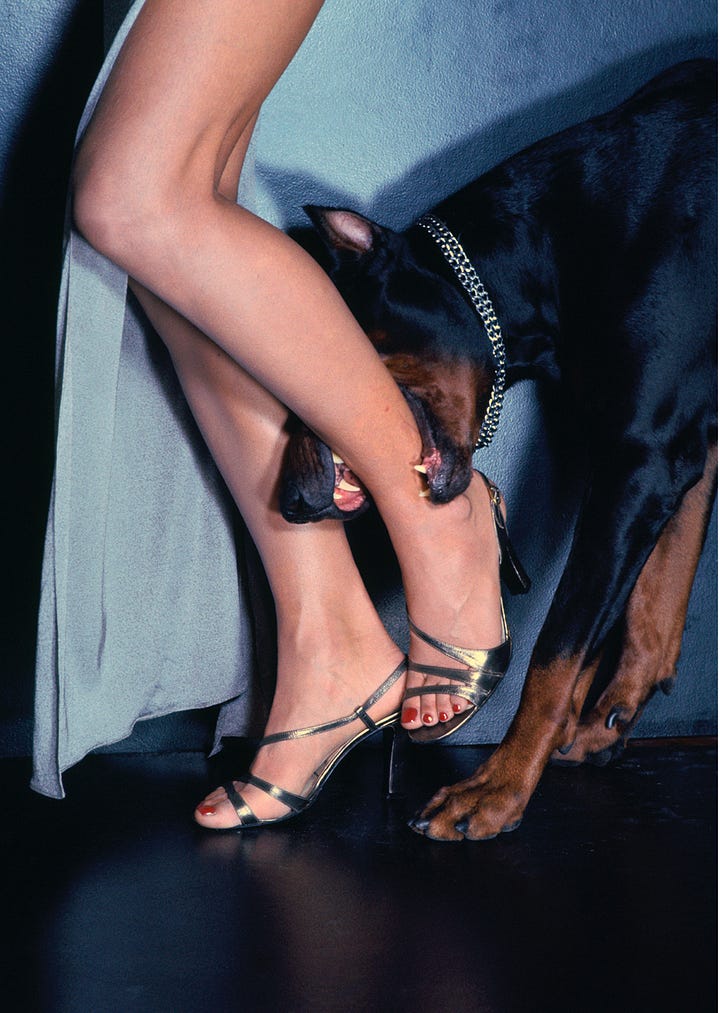
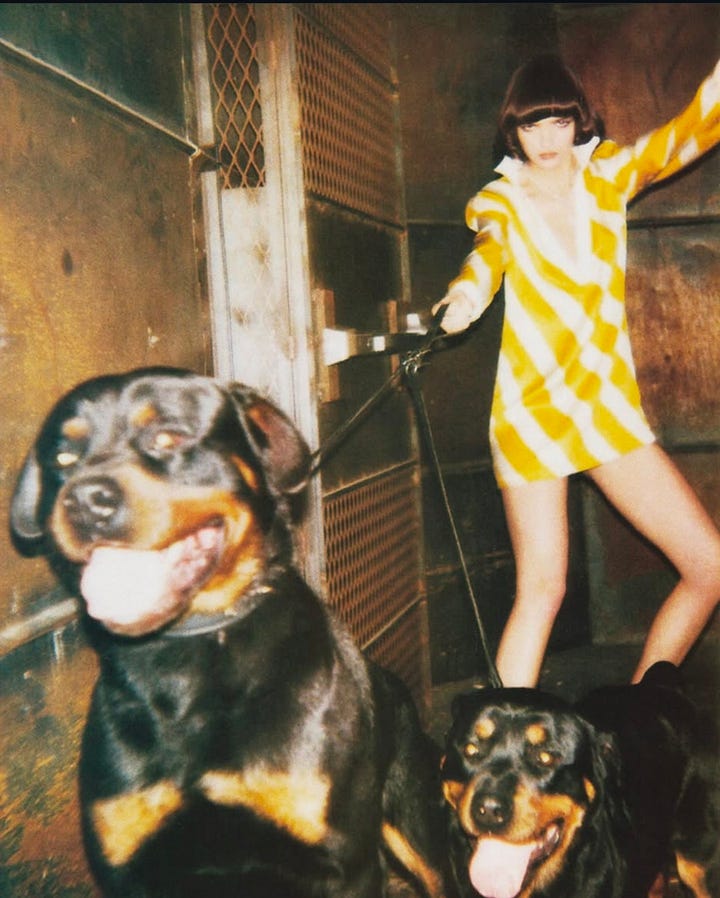

L’essere selvaggio non è che lo stato naturale, primigenio, dell’uomo. La storia, l’educazione, la cultura dovrebbero incivilirlo ma a volte torna fuori. Soprattutto in situazioni di pericolo: in quei momenti non ci sono regole, figuriamoci cortesie.
In queste immagini che ho raccolto le bestie feroci, per lo più cani, simboleggiano quella natura selvaggia che qualcuno conserva in sé e che stride così tanto di fronte alla purezza di un corpo femminile fragile e indifeso.
In un mondo che altro non è che una giungla apparentemente civilizzata bisogna girare col coltello tra i denti, sempre pronti a difendersi, senza mai abbassare la guardia. La poetessa americana Marianne Moore (1887-1972), nel suo saggio sui coltelli, scrisse: “Sì, un coltello è essenziale” (potete leggerlo qui).
Nessuno ci assicura nulla, nessuno ci protegge, tutto quello che abbiamo è il nostro istinto di sopravvivenza. Poi alcuni sono più bravi a lottare, ma capita a tutti di perdere. Non è il perdere che fa di noi vittime sfortunate, bensì il rinunciare alla lotta.
Being wild is but the natural, primal state of man. History, education, culture should incivilize it but sometimes it comes back out. Especially in dangerous situations: in those moments there are no rules, let alone courtesies. In these images I have collected, the ferocious beasts, mostly dogs, symbolize that wild nature that some people retain within themselves and that jar so much in the face of the purity of a fragile and defenseless female body.
In a world that is nothing but a seemingly civilized jungle one must walk around with a knife between one's teeth, always ready to defend oneself, never letting one's guard down. American poet Marianne Moore (1887-1972), in her essay on knives, wrote, “Yes, a knife is essential”. No one assures us of anything, no one protects us, all we have is our survival instinct. Then some people are better at fighting, but it happens to everyone to lose. It is not losing that makes us unfortunate victims, but giving up the fight.
Nicolas Cage (1964) nei panni di Sailor in Wild at heart, il film di David Lynch del 1990, indossando una giacca di pelle di serpente, dice che quella è il simbolo della sua indipendenza e della sua libertà: “This is a snakeskin jacket! And for me it's a symbol of my individuality, and my belief in personal freedom”.
Il film, che è un un road movie pazzo e visionario, racconta la storia di due amanti, Sailor e Lula, in fuga da una realtà violenta. Sailor, infatti, ha ucciso un uomo, questo sì un gesto di sopravvivenza, per legittima difesa. Seppur omicida, non è un violento, vive per l’amore di Lula. Inizia dunque una fuga con lei, per le strade deserte dell’America: eccoli sfrecciare su una decappottabile col vento tra i capelli sulle note di Wicked Game di Chris Isaak, soli con il loro amore, completamente abbandonati quando sono a letto, il fuoco è il simbolo della loro passione.
Il titolo allude al fatto che, nonostante il contesto crudele, i due amanti sono uniti da un amore che è selvaggio, esplicito, ma sincero e in qualche modo puro. Nella realtà incomprensibile in cui vivono, fitta di personaggi strani e subdolmente maligni, ognuno ha solo l’altro su cui contare. A un certo punto Lula dice: “This whole world is wild at heart and weird on top”.
Nicolas Cage (1964) as Sailor in Wild at heart, David Lynch's 1990 film, wearing a snakeskin jacket, says that that is a symbol of his independence and freedom: “This is a snakeskin jacket! And for me it's a symbol of my individuality, and my belief in personal freedom.”
The film, which is a crazy, visionary road movie, tells the story of two lovers, Sailor and Lula, fleeing from a violent reality. Sailor, in fact, killed a man, this one an act of survival, in self-defense. Though homicidal, he is not violent; he lives for Lula's love. So he begins a getaway with her, through the deserted streets of America: here they speed along in a convertible with the wind in their hair to the notes of Chris Isaak's Wicked Game, alone with their love, completely abandoned when they are in bed, the fire a symbol of their passion.
The title alludes to the fact that despite the cruel context, the two lovers are united by a love that is wild, explicit, but sincere and somehow pure. In the incomprehensible reality they experience, thick with strange and deviously malicious characters, each has only the other to rely on. At one point Lula says, “This whole world is wild at heart and weird on top.”
News, events, exhibitions, articles
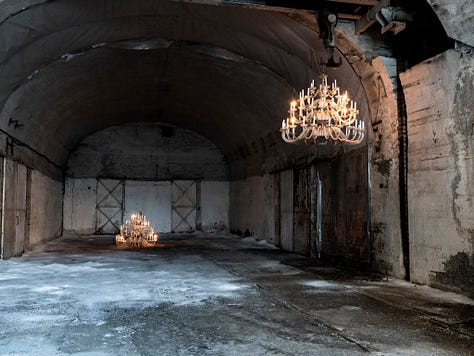
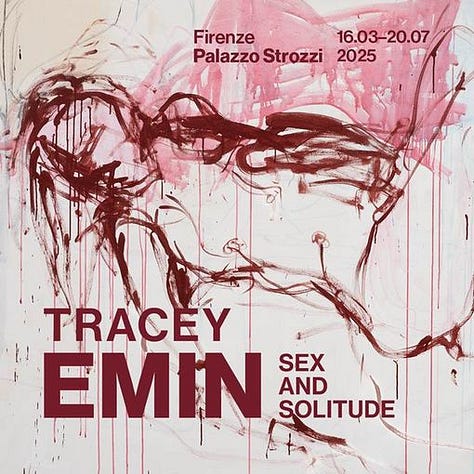

E’ iniziato il Salone del Mobile a Milano, qui una guida agli eventi imperdibili.
Francesco Clemente è un artista che mi piace molto, qui una videointervista in occasione della grande mostra al Palazzo delle Esposizioni a Roma che ho visto.
C’è modo e modo di trattare il contemporaneo, questo è quello sbagliato.
ROMA
Bellissima mostra organizzata dall’Aeronautica Militare sull’artista futurista Tullio Crali, da sabato 5 aprile a domenica 11 maggio.
Le foto italiane del grande Richard Avedon in mostra alla Gagosian. La serie di scatti del fotografo di moda per le strade della Capitale, della Sicilia e di Venezia viene proposta per la prima volta nella sua interezza e in dialogo con gli inimitabili ritratti di personaggi famosi. Fino al 17 maggio.
La Fondazione Goffredo Parise e Giosetta Fioroni, nata nel 2018 per volontà della stessa artista, si apre alla città tra ricerca e divulgazione. La fondazione ospitata nel suo studio trasteverino è pronta ad avviare nuovi progetti per coinvolgere la città e supportare l’arte contemporanea.
Interessante questa riflessione sulla mostra su Caravaggio ora in corso a Palazzo Barberini e sulla quale anche io ho qualche perplessità.
- The Salone del Mobile in Milan has started, here a guide to must-see events.
- Francesco Clemente is an artist I really like, here a video interview on the occasion of the big exhibition at the Palazzo delle Esposizioni in Rome that I saw.
- There is a way and a way to treat the contemporary, this is the wrong one.
ROME
- Beautiful exhibition organized by the Air Force on futurist artist Tullio Crali, from Saturday, April 5 to Sunday, May 11.
- Italian photos by the great Richard Avedon on display at the Gagosian. The fashion photographer's series of shots of the streets of the capital, Sicily and Venice is offered for the first time in its entirety and in dialogue with the inimitable portraits of famous people. Through May 17.
- The Goffredo Parise and Giosetta Fioroni Foundation, established in 2018 by the artist herself, opens to the city between research and dissemination. The foundation housed in its Trastevere studio is ready to launch new projects to engage the city and support contemporary art.
- Interesting this reflection on the Caravaggio exhibition now underway at Palazzo Barberini and about which I also have some concerns.
ITALIA
ROVIGO Palazzo Roverella ospita la mostra “Hammershøi e i pittori del silenzio tra il Nord Europa e l’Italia”, la prima esposizione italiana dedicata a Vilhelm Hammershøi, il più grande pittore danese della propria epoca, protagonista dell’arte europea tra fine Ottocento e inizio Novecento. Fino al 29 giugno.
FIRENZE Ha da poco aperto a Palazzo Strozzi la mostra, che non è una retrospettiva, ma un progetto realizzato da e con Tracey Emin a Firenze. L’ho vista ed è davvero una bella mostra. Sex and solitude, fino al 20 luglio.
MILANO L’artista Gian Maria Tosatti ha creato Paradiso, una monumentale opera ambientale che si sviluppa su una superficie di 3mila metri quadrati presso gli ex Magazzini Raccordati della Stazione Centrale di Milano. L’intervento è accompagnato dalla mostra Es Brent (Brucia!) presso la sede milanese di Galleria Lia Rumma. Fino all’11 aprile.
PARMA Il Labirinto della Masone festeggia i suoi 10 anni con la mostra di Luigi Serafini (e del suo Codex), scoperto da Franco Maria Ricci negli Anni Ottanta. Dal 28 marzo e fino al 13 luglio.
PARMA Una mostra dedicata ai fiori nell’arte, dal Simbolismo al Contemporaneo, alla Fondazione Magnani-Rocca, con oltre 150 opere. Un’occasione anche per scoprire il restauro del parco di dodici ettari che circonda la dimora storica. Fino al 29 giugno.
NAPOLI La Galerie Gisela Capitain di Colonia, ha ideato una mostra d’arte contemporanea diffusa tra un palazzo ottocentesco (Palazzo Degas) e la vecchia Stazione Zoologica Anton Dohrn. Fino al 16 maggio.
VENEZIA E’ l’anno della Biennale di Architettura, che aprirà dal 10 maggio e fino al 23 novembre e che prevede ben 11 progetti collaterali. Tra questi l’attesissima mostra su Giulio Aristide Sartorio alla Galleria Internazionale d’Arte Moderna di Ca’ Pesaro, in cui si esporrà il Poema della vita umana, ciclo realizzato per la Biennale di Venezia del 1907 e dopo un accurato restauro è ritornato al museo nel gennaio 2020, poco prima del lockdown. Dal 16 maggio al 28 settembre.
ITALY
- ROVIGO Palazzo Roverella hosts the exhibition “Hammershøi and the Painters of Silence between Northern Europe and Italy,” the first Italian exhibition dedicated to Vilhelm Hammershøi, the greatest Danish painter of his time and a leading figure in European art between the late 19th and early 20th centuries. Through June 29.
- FLORENCE An exhibition, which is not a retrospective but a project by and with Tracey Emin in Florence, has recently opened at Palazzo Strozzi. I have seen it and it is a really good exhibition. Sex and solitude, through July 20.
- MILAN Artist Gian Maria Tosatti has created Paradiso, a monumental environmental work spanning 3,000 square meters at the former Magazzini Raccordati at Milan's Central Station. The intervention is accompanied by the exhibition Es Brent (Burn!) at the Milan branch of Galleria Lia Rumma. Through April 11.
- PARMA The Labirinto della Masone celebrates its 10th anniversary with an exhibition of Luigi Serafini (and his Codex), discovered by Franco Maria Ricci in the 1980s. From March 28 through July 13.
- PARMA An exhibition dedicated to flowers in art, from Symbolism to the Contemporary, at the Magnani-Rocca Foundation, with more than 150 works. Also an opportunity to discover the restoration of the 12-acre park surrounding the historic home. Through June 29.
- NAPLES Cologne's Galerie Gisela Capitain has designed a contemporary art exhibition spread between a 19th-century palace (Palazzo Degas) and the old Anton Dohrn Zoological Station. Through May 16.
- VENICE It's the year of the Architecture Biennale, opening May 10 through Nov. 23, and featuring as many as 11 side projects. Among them is the highly anticipated exhibition on Giulio Aristide Sartorio at the International Gallery of Modern Art at Ca' Pesaro, which will show Poem of Human Life, a cycle created for the 1907 Venice Biennale and after careful restoration returned to the museum in January 2020, just before the lockdown. May 16 through Sept. 28.
ALTROVE
NEW YORK Riapre la Frick Collection rinnovata e ampliata! Dal 17 aprile.
BRUXELLES La mostra d’arte africana più grande degli ultimi 100 anni celebra la molteplicità delle esperienze nere, non distorte da uno “sguardo bianco”, grazie alla curatela di Koyo Kouoh, direttrice artistica della prossima Biennale Arte di Venezia. When We See Us: A Century of Black Figuration in Painting, fino al 10 agosto.
AMSTERDAM Non è un artista che mi seguo particolarmente, ma questa grande retrospettiva di Anselm Kiefer sembra essere importante, tanto più perché coinvolge due importanti istituzioni museali della città ovvero il Van Gogh Museum e lo Stedelijk Museum. Fino al 9 giugno.
BASILEA La Fondation Beyeler dedica una grande mostra alle avanguardie nordiche, da Hilma af Klint a Edvard Munch con 70 dipinti eseguiti da 13 pittori tra il 1880 e il 1930. Fino al 25 maggio.
BERNA Il Kunstmuseum terrà, nel corso del 2025, delle ambiziose monografiche dedicate alle due artiste (entrambe torinesi) che hanno rivoluzionato la pratica artistica del Novecento: Marisa Merz e Carol Rama.
PARIGI La storica sala cinematografica La Pagode si prepara a riaprire nel 2025 grazie all’ambizioso progetto dello studio Loci Anima. Evviva!
LONDRA Da giugno la prima retrospettiva di Jenny Saville in un museo nazionale, la National Portrait Gallery. Jenny Saville: The Anatomy of Painting, dal 20 giugno e fino al 7 settembre.
ELSEWHERE
- NEW YORK The renovated and expanded Frick Collection reopens! From April 17.
- BRUSSELS The largest African art exhibition in 100 years celebrates the multiplicity of black experiences, undistorted by a “white gaze,” thanks to the curatorship of Koyo Kouoh, artistic director of the upcoming Venice Art Biennale. When We See Us: A Century of Black Figuration in Painting, through Aug. 10.
- AMSTERDAM He is not an artist I particularly follow, but this major Anselm Kiefer retrospective seems to be important, all the more so because it involves two major museum institutions in the city namely the Van Gogh Museum and the Stedelijk Museum. Through June 9.
- BASELEA The Fondation Beyeler devotes a major exhibition to the Nordic avant-garde, from Hilma af Klint to Edvard Munch with 70 paintings executed by 13 painters between 1880 and 1930. Through May 25.
- BERN The Kunstmuseum will hold ambitious monographs during 2025 devoted to the two artists (both from Turin) who revolutionized twentieth-century art practice: Marisa Merz and Carol Rama.
- PARIS The historic movie theater La Pagode is preparing to reopen in 2025 thanks to an ambitious project by studio Loci Anima. Yay!
- LONDON From June the first Jenny Saville retrospective in a national museum, the National Portrait Gallery. Jenny Saville: The Anatomy of Painting, from June 20 through Sept. 7.
Rocaille Experience:
The Secrets of Tuscia IV | 23-24-25 May 2025
Un viaggio di 3 giorni e 2 notti alla scoperta della Tuscia, la zona senza confini precisi che si divide tra il Lazio, la Toscana e l'Umbria. Partiremo da Bolsena, soggiornando nel b&b più bello del paese, che è anche una dimora storica: Palazzo Cozza Caposavi. Qui, nel grande salone affrescato, avremo la possibilità esclusiva di fare una cena a lume di candela: sarà un’occasione per presentarci e conoscerci meglio prima di partire per l’esplorazione. Il programma prevede la visita esclusiva di due dimore storiche: castelli, giardini segreti, ville, residenze d’artista. Si tratta sempre di luoghi fuori dalle rotte del turismo di massa e che raccontano storie e realtà spesso poco conosciute.
QUANDO?
Le attività dell'Experience coprono il quarto fine settimana di maggio: iniziano ufficialmente la sera del 23 maggio, con la cena nel palazzo, e finiscono la mattina (compresa) di domenica 25.
QUANTO?
La quota è a partire da 540€ per una persona singola / 900€ per una coppia.
COMPRENDE:
- 2 notti a Palazzo Cozza Caposavi (servizio b&b con colazione inclusa);
- 2 visite private con guida in due dimore storiche;
- una cena esclusiva a Palazzo Cozza Caposavi;
- mio accompagnamento durante tutta la durata del viaggio;
- mio ebook "Guida Rocaille alla Tuscia"
NON COMPRENDE: trasporti o altro non specificato.
COME PRENOTARE?
Dopo aver compilato il form qui, vi manderò le istruzioni per il pagamento.
PS E’ possibile prenotare fino ad esaurimento delle camere del palazzo (15).
NE SONO RIMASTE 5.
HAI DOMANDE?
Scrivimi a info@rocaille.it
A 3-day, 2-night trip to discover Tuscia, the area without precise borders that divides Lazio, Tuscany and Umbria. We will start from Bolsena, staying in the most beautiful b&b in the town, which is also a historical residence: Palazzo Cozza Caposavi. Here, in the large frescoed hall, we will have the exclusive opportunity to have a candlelight dinner: it will be an opportunity to introduce ourselves and get to know each other better before leaving for exploration. The program will include exclusive visits to two historical residences: castles, secret gardens, villas, artist residences. These are always places off the beaten path of mass tourism and tell stories and realities that are often little known.
WHEN
The Experience activities cover the fourth weekend in May: they officially begin on the evening of May 23, with dinner in the palace, and end on the morning (inclusive) of Sunday 25.
HOW MUCH?
The fee is from €540 for a single person / €900 for a couple.
INCLUDES:
- 2 nights at Palazzo Cozza Caposavi (b&b service with breakfast included);
- 2 private guided tours of two historic mansions;
- an exclusive dinner at Palazzo Cozza Caposavi;
- my accompaniment throughout the trip;
- my ebook “Rocaille Guide to Tuscia”
DOES NOT INCLUDE: transportation or other not specified.
HOW TO BOOK?
After filling out the form here , I will send you instructions for payment.
PS It is possible to make reservations while the building's rooms last (15). There are 5 left!
DO YOU HAVE QUESTIONS? Write to me at info@rocaille.it
PREVIEW
Exclusive newsletter - March 2025
The next exclusive newsletter will be an Usual guide to Florence.
Out on April 15.

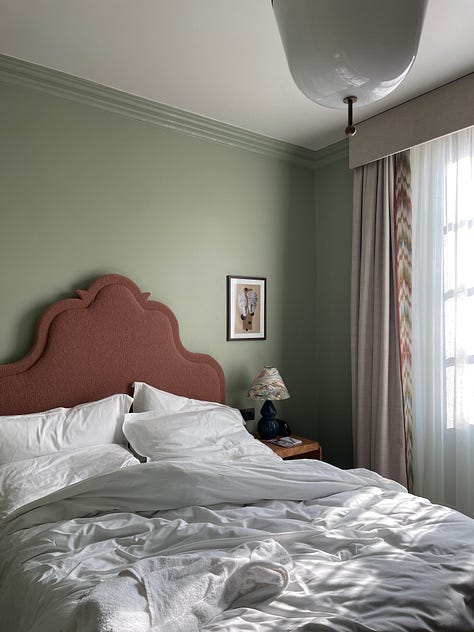
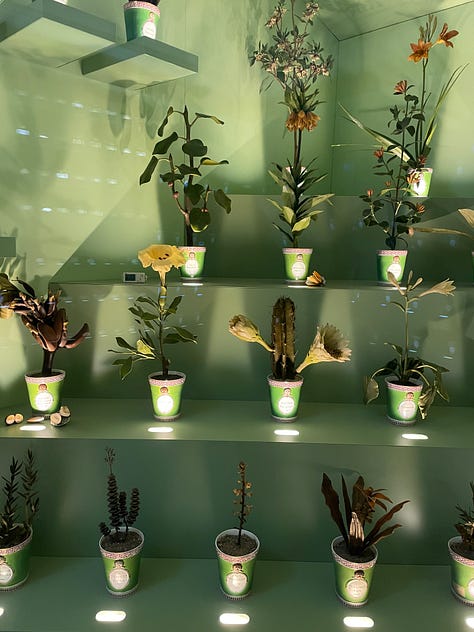
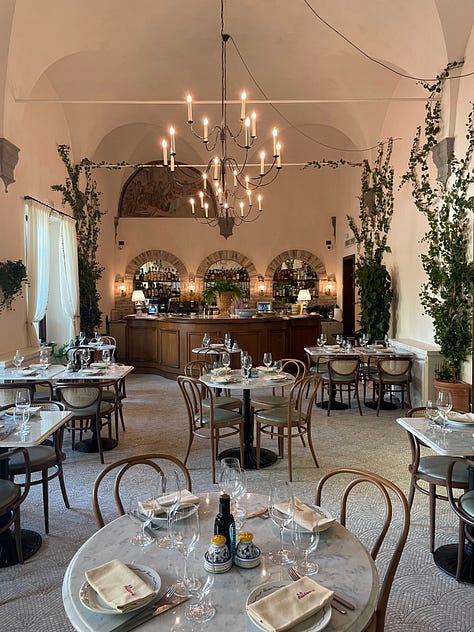

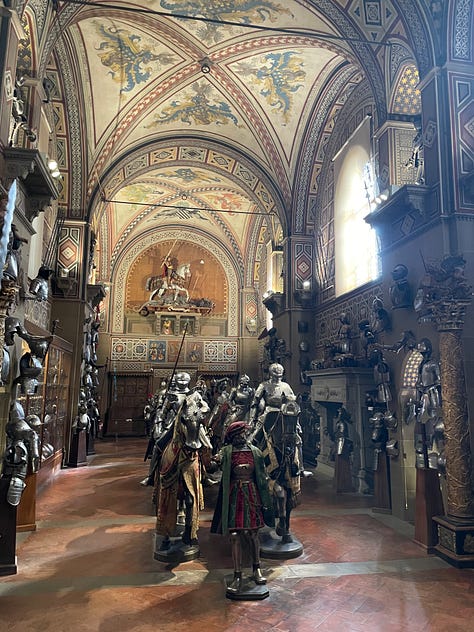
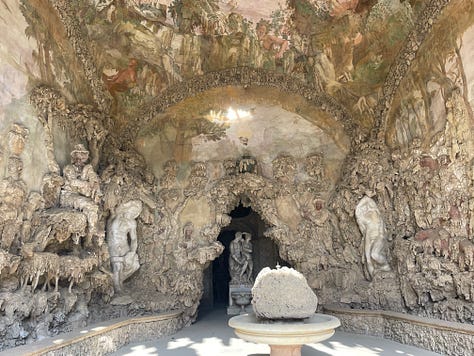
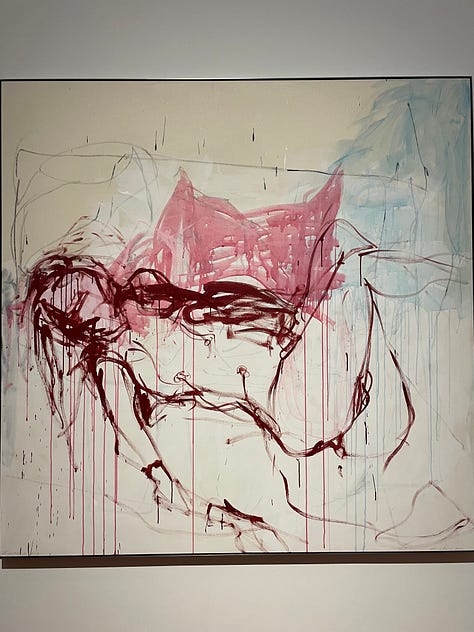
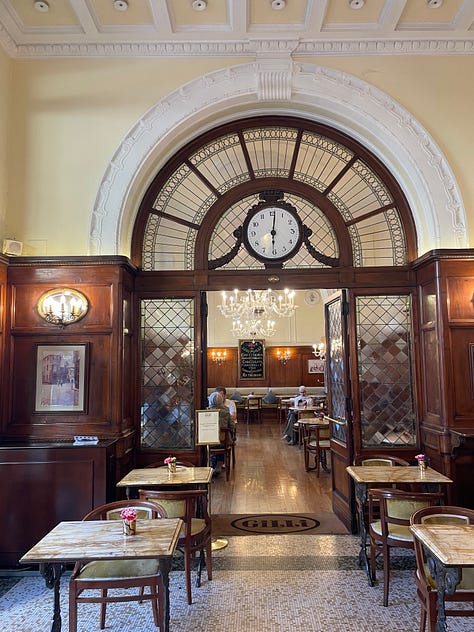
New on the blog:
CASTELLO DEL CALCIONE, TUSCANY
La storia del castello del Calcione, di origine antichissima, situato a metà strada tra Siena e Arezzo che nel 1500 ospitò anche Leonardo Da Vinci. Dal 1483 è di proprietà della famiglia della Stufa, che lo trasformò in residenza di campagna e oggi lo gestisce come resort, con una particolare attenzione per i cavalli.
The history of Calcione Castle, of very ancient origin, located halfway between Siena and Arezzo, which in 1500 also hosted Leonardo Da Vinci. Since 1483 it has been owned by the della Stufa family, which turned it into a country residence and now runs it as a resort, with a special focus on horses.
BUY MY EBOOKS
(italian & english)
